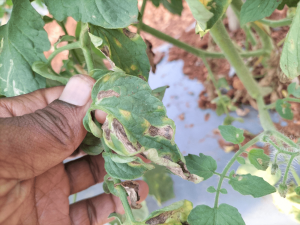Early blight is a common fungal disease that affects tomato plants. Since it affects the growth of plants early in the season, it is called ‘early blight’. It is caused by the fungus Alternaria solani and can be a significant problem in warm, humid environments. The fungus can also infect the potato crop. Alternaria solani can invade and infect any part of the host plant, such as leaves, stems and even fruits. The plant with infections yields poor quality fruits. Learn how to recognize the symptoms of early blight, what causes it, and most importantly, how to prevent and manage it in your fields in this article.
Early Blight in Tomato Symptoms
- Circular, dark brown to black spots with dark concentric rings, typically 1 – 1.5 cm in diameter, can be observed on affected leaves.
- The appearance of these spots is often compared to a “Bull’s eye”.
- As the infection progresses, the spots may merge, causing the affected leaves to turn yellow and defoliate.
- The disease initially affects older leaves and can later spread to the stems and fruits.
- In severe cases, stem lesions may appear, causing the plant to wilt and die.
- Just like on leaves, the disease may cause circular lesions with concentric rings on the fruits.
- Later, these spots may enlarge and become dark and sunken.

Early blight symptom in tomato plant
How is it caused?
- The fungus can overwinter on plant debris and soil and can also be introduced to a field through contaminated seeds or transplants.
- It thrives in wet and humid conditions, so rainy weather or overhead irrigation can promote disease development.
- Tomato plants that are deficient in nutrients can be more susceptible to early blight.
Preventive Measures
- Adopt crop rotation with non-Solanaceae family crops such as legumes (e.g. beans, peas), brassicas (e.g. cauliflower, cabbage), or grains (e.g. wheat, barley) to reduce the buildup of fungal spores in the soil.
- Avoid transplanting seedlings that show symptoms of early blight into the main field.
- Plant tomatoes with adequate spacing to improve air circulation and reduce humidity around the plants.
- Grow disease tolerant varieties like Indus 1030 tomato, Bangalore red tomato.
- Ensure balanced nutrition for the crop to improve its ability to withstand the disease.
- Remove and destroy the plant debris properly after harvest to prevent the spread of the disease.
- Avoid doing any intercultural activities during moist days.
- Keep the field weed-free as weeds can act as alternate hosts for the pathogen.
- Avoid overhead irrigation which can promote fungal growth.
Management of Early blight disease in Tomato
| Product name | Technical content | Dosage |
| Biological Management | ||
| Geolife Recover Nutri Fungicide | Natural extracts & antioxidants | 1 gm/lit of water |
| Multiplex Bio Jodi Fungicide | Pseudomonas fluorescence & Bacillus subtilis | Spray: 5 – 10 gm/lit of water
Soil Application: 5 kg of product + 100 kg of FYM per acre |
| Chemical Management | ||
| Acrobat Fungicide | Dimethomorph 50% WP | 2 gm/lit of water |
| Cuman L Fungicide | Ziram 27% SC | 2 ml/lit of water |
| Merivon Fungicide | Fluxapyroxad 250 G/L + Pyraclostrobin 250 G/L SC | 0.5 ml/lit of water |
| Custodia Fungicide | Azoxystrobin 11% + Tebuconazole 18.3% SC | 1 ml/lit of water |
| Conika Fungicide | Kasugamycin 5% + Copper Oxychloride 45% WP | 1.5 gm/lit of water |
| Kocide Fungicide | Copper Hydroxide 53.8% DF | 2 gm/lit of water |
| Dhanuka M45 Fungicide | Mancozeb 75% WP | 3 gm/lit of water |
Note: Please follow the product’s label to know the right time of application.
Explore our comprehensive guide on tomato farming for more insights. CLICK HERE





